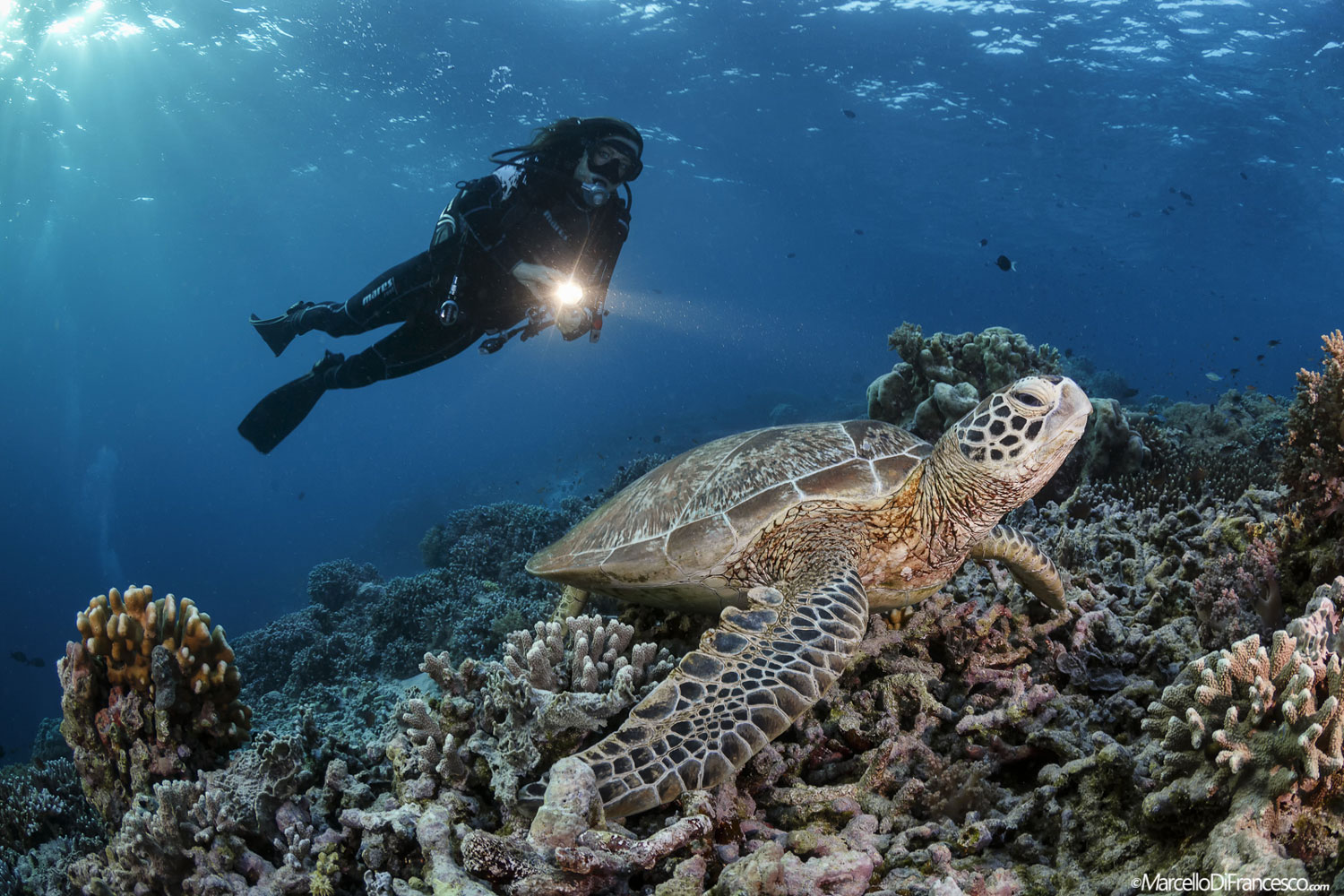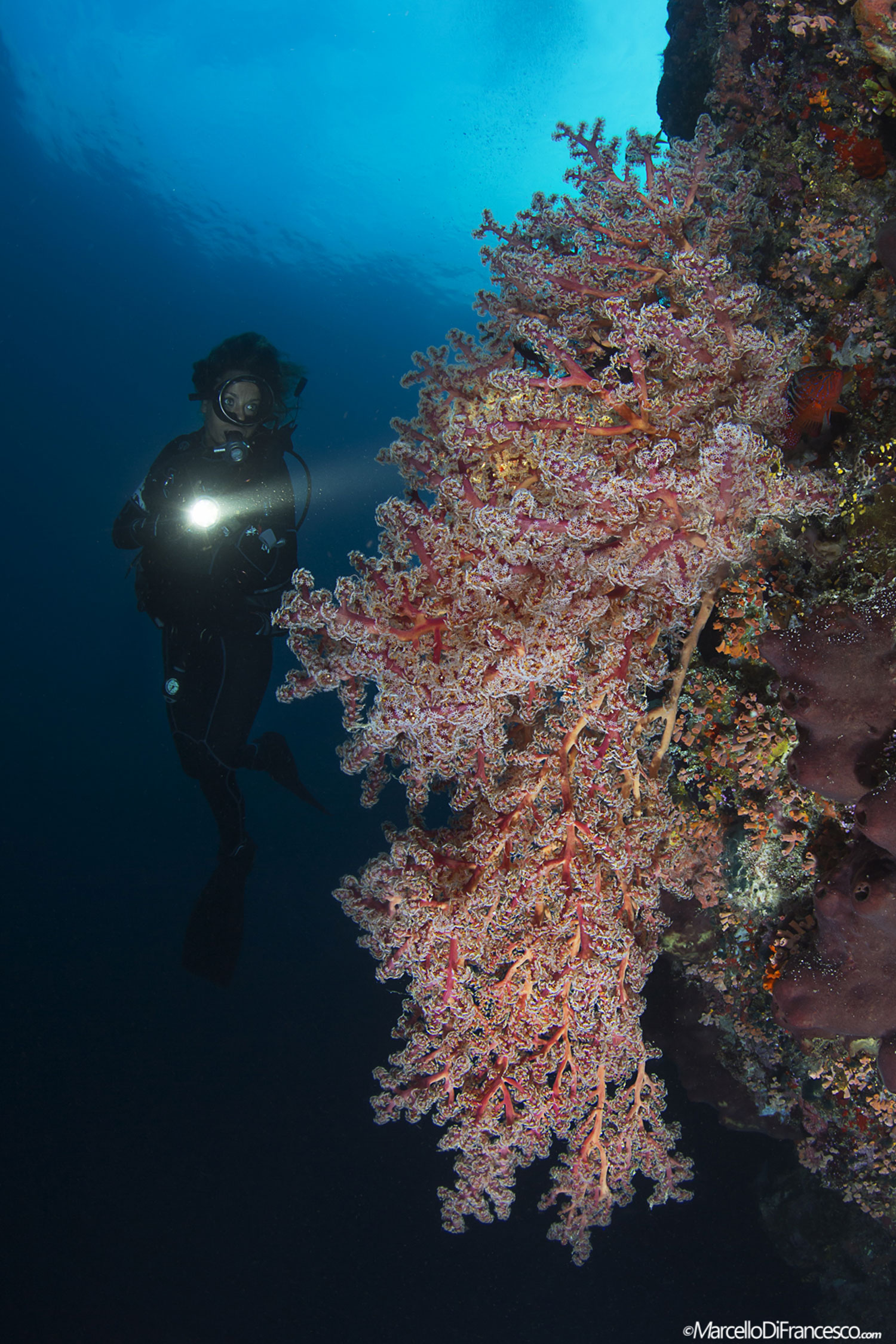The Top 50 Cult Dive Spots
Cult Dive: Barracuda Point Sipadan Island
Dive site: Barracuda Point
Location: Malesia, Sipadan Island, 4° 6′ N / 118° 37′ E
Type of dive: Wall, drift
Maximum depth: 40 mt
Level: intermediate to advanced in case of current
Water temperature: 27° C – 29° C
When to go: You can dive here year-round, but the best time is from April to December, with top conditions in July and August; from January until March it rains a lot, and thus the visibility can be very limited.
 School of jack fish swirling, an experience not to be missed in the waters of the Island of Sipadan. (Canon 5Dmk3 + Tokina 10-17mm Nauticam Housing – F10 1/125 iso 200)
School of jack fish swirling, an experience not to be missed in the waters of the Island of Sipadan. (Canon 5Dmk3 + Tokina 10-17mm Nauticam Housing – F10 1/125 iso 200)
This site is located in the Malaysian Borneo, off the famous Island of Sipadan in the Celebes Sea; a magic and captivating place that Jacques Cousteau, exactly 50 years ago, described as a unique and intact work of art! Nowadays it is one of the 5 marine parks established by the Malaysian government.
It is no coincidence that this has always been considered one of the top diving destinations world-wide, whether for the quality of its dive sites, or especially for the exuberance of its underwater habitats, very rich with life and a high biodiversity, home to over 3000 species of fish and hundreds of different classified corals.
For sure, Barracuda point is one of the most precious dive spots in this whole stretch of sea: its geographic location and unique structure allow for a concentration of huge schools of pelagic predators in these waters; fish abound here, with impenetrable walls of barracudas and jack fish circling around and above divers, countless species of smaller fish coloring the reefs, and turtles swimming undisturbed all around.
 Green turtle busy eating, one of the many encounters in this amazing sea. (Canon 5Dmk3 + Tokina 10-17mm Nauticam Housing – F9 1/60 iso 200)
Green turtle busy eating, one of the many encounters in this amazing sea. (Canon 5Dmk3 + Tokina 10-17mm Nauticam Housing – F9 1/60 iso 200)
Dive Briefing: this dive site can be reached in approximately 45 minutes’ navigation from the town of Semporna, or 25 minutes from the Island of Mabul; to better protect these sites, the Malaysian government allows a maximum of 120 divers per day to visit the different resorts in the area. Usually, full days are organized leaving at 05:00 a.m. so as to be in the water for the first dive at dawn, as this is the best time to encounter large schools of humphead parrot fish that, in very long single files, swim in shallow water on the reef’s plateau.
 Whirlwind of humphead parrot fish, shot at dawn on the shallow part of the reef at barracuda point. (Canon 5Dmk3 + Tokina 10-17mm Nauticam Housing – F10 1/80 iso 160)
Whirlwind of humphead parrot fish, shot at dawn on the shallow part of the reef at barracuda point. (Canon 5Dmk3 + Tokina 10-17mm Nauticam Housing – F10 1/80 iso 160)
Upon reaching the dive site, the guides will check the current, and, depending upon intensity and direction, will decide on which side of the reef to start going down. The dive unfolds following a vertical wall that is extraordinarily rich with life: huge gorgonian sea fans, sponges, and black coral interchange with soft corals of all shapes and colors, giving life to a landscape of exceptional beauty that is literally teeming with life.
 The colorful wall of Barracuda point. (Canon 5Dmk3 + Tokina 10-17mm Nauticam Housing – F13 1/100 iso 320)
The colorful wall of Barracuda point. (Canon 5Dmk3 + Tokina 10-17mm Nauticam Housing – F13 1/100 iso 320)
Barracuda point is still one of the few places left in the world where you can encounter swirling schools of jack fish. The show is unbelievable: hundreds of fish swim in unison, perfectly synchronized; they are so many that they form impenetrable barriers to sunlight. Their movements are slow and winding, opening up to form real whirlwinds as a diver passes! It is a performance of rare beauty that will leave even the most seasoned divers in awe.
 Jack fish. (Canon 5Dmk3 + Tokina 10-17mm Nauticam Housing – F13 1/125 iso 200)
Jack fish. (Canon 5Dmk3 + Tokina 10-17mm Nauticam Housing – F13 1/125 iso 200)
 Jack fish and Reef life. (Canon 5Dmk3 + Tokina 10-17mm Nauticam Housing – F9 1/200 iso 200)
Jack fish and Reef life. (Canon 5Dmk3 + Tokina 10-17mm Nauticam Housing – F9 1/200 iso 200)
Going on with the dive, you reach a plateau that forms a small “saddle” at a depth of approximately 22 meters and where, off in the blue, barracudas gather. If the current is not too strong, you can leave the wall and swim towards them, so as to observe them even more closely.
 School of barracudas. (Canon 5Dmk3 + Tokina 10-17mm Nauticam Housing – F10 1/30 iso 200)
School of barracudas. (Canon 5Dmk3 + Tokina 10-17mm Nauticam Housing – F10 1/30 iso 200)
The numerous schools of fish are not the only attraction of this dive site; it is enough to direct your gaze to the blue, and often you will see white tip or grey reef sharks materializing in front of you, patrolling the reef in search of lunch, large tunas, and giant solitary barracudas scanning the perimeter of the wall. Often you also encounter turtles, napoleon fish, and eagle rays.
 White tip sharks hunting on the reef. (Canon 5Dmk3 + Tokina 10-17mm Nauticam Housing – F8 1/100 iso 250)
White tip sharks hunting on the reef. (Canon 5Dmk3 + Tokina 10-17mm Nauticam Housing – F8 1/100 iso 250)
 A wall of barracudas, magic in the Malaysian waters. (Canon 5Dmk3 + Tokina 10-17mm Nauticam Housing – F11 1/160 iso 200)
A wall of barracudas, magic in the Malaysian waters. (Canon 5Dmk3 + Tokina 10-17mm Nauticam Housing – F11 1/160 iso 200)
Safety recommendations: always check the intensity of the current, as it may change very suddenly during the same dive; also, be extra careful when, hypnotized by the beauty of the schools of jack fish, you start swimming with them into the blue. Without realizing it, you could find yourself far, without any reference point, and having lost sight of the wall. Your dive would end with an ascent in the blue, and surely far away from the island. Always make sure to carry an SMB (Surface Marker Buoy) with you, and try to remain focused on your orientation by keeping the wall in sight.
“I have seen other places like Sipadan… 45 years ago. Now we have found again an untouched piece of art.” J.Cousteau
Underwater photography recommendations: taking pictures of huge schools of fish is surely one of the greatest challenges for underwater photographers! The most problematic issue will be managing the exposure, as the light changes suddenly and the fish can literally block out the sun, changing your light meter reading by a great deal, and making things even harder. The use of cameras with WDR (Wide Dynamic Range) sensors can definitely help when editing your pictures, but, in wider terms, I suggest to follow the action while looking at the light meter directly in the viewfinder, and quickly adjusting exposure times as to avoid areas with high lights looking burned while other parts being very underexposed. Try, when possible, to always keep your eyes and hands on the camera, while you try to correctly compose and expose the image.
Conservation: even at present, Sipadan holds the charm of bygone times, and its underwater landscapes are still rich with life. Since 2006, Malaysia has not only established the Marine Protected Area, but is implementing a plan for the conservation of the marine habitat (especially with regards to sharks), launching numerous initiatives aimed at raising its citizens’ environmental awareness. Only through enhancing education and sensitizing local fishermen and common people to the importance of preserving natural resources it will be possible to achieve visible and tangible results.
About the author:
Marcello Di Francesco is a dive instructor, freelance photographer specialized in underwater naturalistic imagery, and travel enthusiast. At present, he is a Federal FIPSAS judge for National contests of digital underwater photography, and was called numerous times to be a part of national and international panels of judges for various contests of underwater photography.

